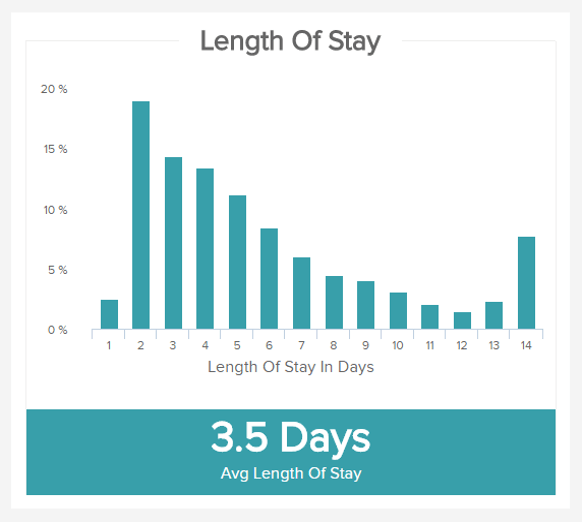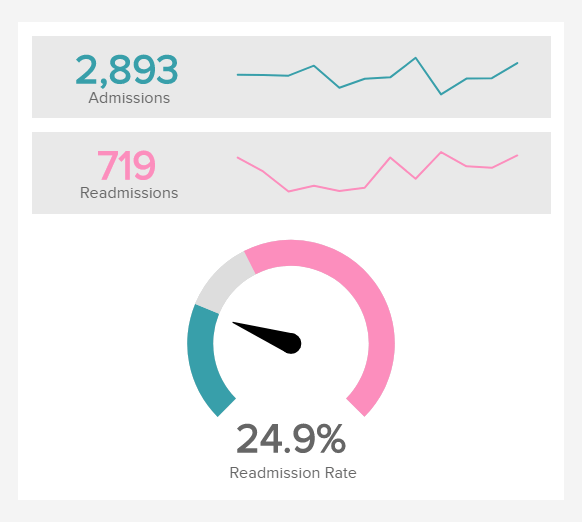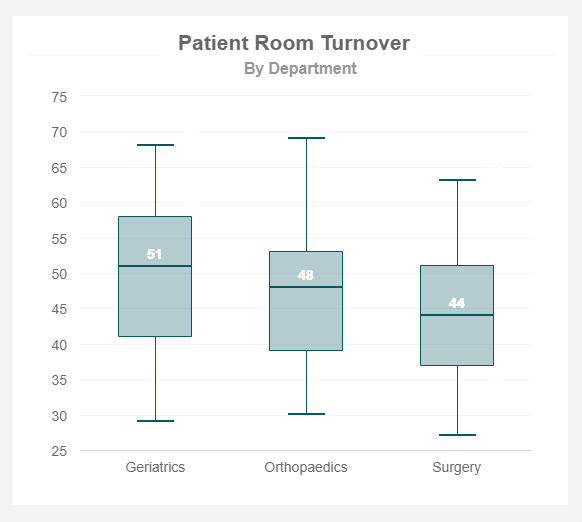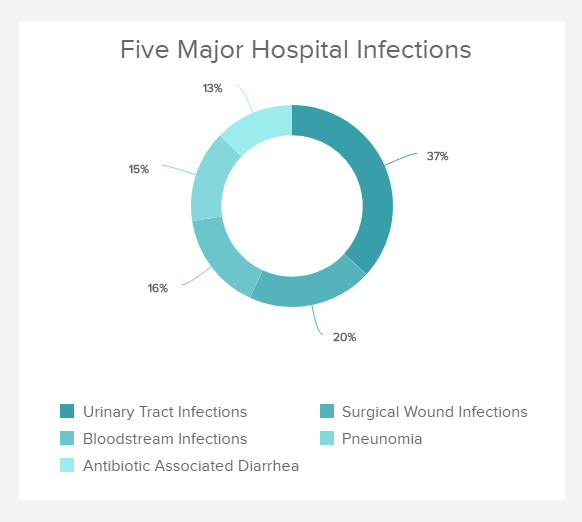A healthcare KPI, or metric, is a type of performance indicator that helps you understand how your healthcare institution or department is performing. A good healthcare KPI should be well defined, quantifiable, thoroughly reported, and crucial to achieving your strategic goals.
It optimizes all relevant healthcare processes to increase patient satisfaction. Many of these metrics are actually distinct key performance indicators(KPI) for hospitals.

The content below presents the Top 15 Key Performance Indicators(KPI)
1. BED OCCUPANCY TURNOVER–
It’s an important element of analytics, and it immediately shows how many beds were filled during a specific period, expressed in percentage. Higher occupancies could mean plenty of things such as a pandemic but the aim is to keep the occupancy under control, otherwise, there are risks of extreme facility load and higher numbers of infections.
2. MEDICAL EQUIPMENT UTILIZATION-
Technological advancements and more treatment options for patients simply mean higher availability of medical equipment. This could lead to increased costs of maintenance, wrong purchasing decisions, or lower quality of patient care. That’s why hospital key performance indicators such as the medical equipment utilization rate are critical in establishing better hospital management processes.
3) STAFF-TO-PATIENT RATIO-
The staff-to-patient ratio indicates whether your staff management processes are efficient, meaning whether the hospital is understaffed or overstaffed. Staff must be available to provide care to all patients, no matter the time of the day, and even in case of emergency. Different states have different regulations, but the aim is to provide optimal treatment and ensure each patient is taken care of as required.
4) AVERAGE LENGTH OF HOSPITAL STAY–
This metric tracks the period for which the patient stays at a hospital, from the time admitted until the discharge. It is tracked by either quarter, weeks, days, or even by hours. It can either be utilized for the whole hospital or segregate out specific diagnostic facilities.
It signifies how efficient is the organization in terms of treating the patients. According to CDC, it is an average of 4.8 days, and the overnight stay rate is 7.6%

5) TIME TAKEN BY INSURANCE CLAIMS-
It averages the processing cost and time for insurance claims. It depends upon the hospital to which the insurance agency holds its ties. If it is low, it means it’s less expensive for the patient, and the required amount is issued quickly.
6) PATIENTS LEAVING WITHOUT BEING SEEN-
It denotes the number of patients who were unable to wait to see a physician. It shows whether the number of doctors is enough to handle the patient load or not. It also tells the facilities provided in the infrastructure of the hospital.
7) AVERAGE TREATMENT COST
This KPI is the best example of monetary management. Treatment costs are important metrics to track as they directly impact your budget, the contribution limits you make, and the capacity of your facility to sustain itself.
The purpose is not to reduce it as much as possible to make a profit but to spot abnormal or excessive expenses and address them. You can break it down into various categories -per unit, per operations, per age group. By considering these costs, you can also budget better and allow the right amount of money to go to the right category. For instance; 25-year-old patients’ cost of treatment is on average less than 72-year-old patients.

8) PATIENT CONFIDENTIALITY-
This parameter keeps the records of the number of times the patient’s records are not kept confidential or went to an unapproved party. It is key for getting good patient flow who trusts the organization for their personal details.
9) HOSPITAL READMISSION RATES-
The hospital readmission rate presents the data on the number of patients that return to the hospital within a short span of time after being treated. It is one of the most important healthcare metrics as it provides great insight into the quality of care administered in the facility concerned. But it cannot be used as a stand-alone quality indicator.
Readmission rates can also shed the light on other shortcomings the hospital management is subjected to (lack of staff or appropriate material, overloaded staff neglecting details, units with special needs), and may help in better cost control as it aims to decrease expensive and unnecessary readmissions.

10) AVERAGE PATIENT WAIT TIME-
Patient wait time is one of the most important aspects of patient satisfaction. It measures the time it takes for anyone visiting your hospital from the moment they register to when they see a doctor and get treatment. In ideal cases, it is the prompt attention the patient desires.
This healthcare metric is highly linked to the patient satisfaction score, as no one really enjoys staying hours in a hospital. It can also portray some other problems your facility is facing if the figure is too high, and that needs to be looked upon.
11)PATIENT FOLLOW-UP RATE-
The patient follow-up rate is one of the healthcare performance metrics that deal with patients’ care after finishing a particular treatment. The Treatments include simple medical check-ups, physical exams, a new prescription, blood tests, or consultations, among others. The follow-up can be done by a physician, nurse, or administrator, e.g., depending on the type of need.
For example, a follow-up on tuberculosis patients has its purpose to see if the disease returned or spread across the body so it might make sense to track this rate. It is done to see what kind of needs patients have regarding the type of treatment (surgery, gynecological issues, or pediatric follow-ups). That way, the hospital has a better overview of specific departmental performance and, consequently, improves patient outcomes.

12)NO. OF MISSED APPOINTMENTS-
It is a key performance indicator for outpatient clinics as well as hospitals, it is important because it directly affects the efficiency of doctors. If patients don’t attend the scheduled appointment, the result is waste of time. But also the relationship with the physician suffers.
Canceled appointments are also affecting the hospital’s performance. But, if it is canceled on time, doctors and nurses can rearrange the schedule and bring another patient in. Forgetfulness, unable to get time from work/school, sickness, transportation issues, and many other factors can influence this metric. So, you should keep in mind the causes that increase the percentage of canceled or missed appointments.
13)NUMBER OF MEDIA MENTIONS-
It is simply for promoting the healthcare facilities available with the hospital. If the parameters governing the functionality of the hospital are up to the mark then the media focuses on highlighting them.
The advantage of this is that more patients will be trusting this model of healthcare. Hence, improving the business of hospitals.
14)PATIENT SAFETY-
Patient safety measures the capacity of a hospital to deliver quality care to its patients. It keeps them safe from contracting a new infection, post-operation complications, or any kind of sepsis. This is extremely important to track this metric regularly to know where problems occur, which stage of the process can be improved, and identify any infection abnormally present in the hospital.
You can measure this metric and break it down into distinct categories (post-operation infections, respiratory infections, or treatment-related diseases), to have an even more accurate view of the hospital performance.

15) OVERALL PATIENT SATISFACTION-
This is another great healthcare KPI example that should be a top priority for any healthcare organization. So, that it has ample feedback and improves the service. You can ask your patients how they felt while being taken care of. How they would rate their meals, or the time taken by doctors and nurses to explain their situation.
Such assessment will provide you insights into the overall approach of your hospital services and show you which areas can be improved. Besides, your patients will feel satisfied as their opinion and feelings are taken into account.
THE LAST NOTE-
This blog must have initiated your thought process for acquiring more in-depth knowledge for enhancing the overall growth of your hospital.
Join our team of doctors to excel in your business. The Doctorpreneur Academy has it all.
For more insights into these managerial skills, we invite you to attend our FREE webinar workshop.



